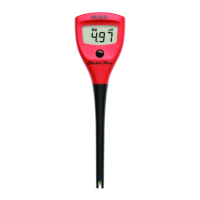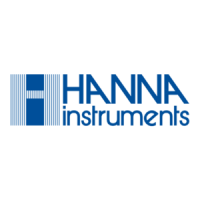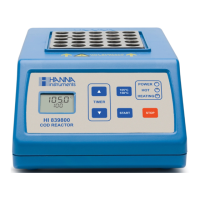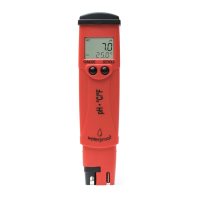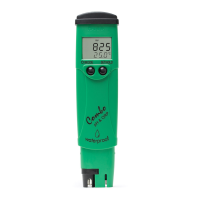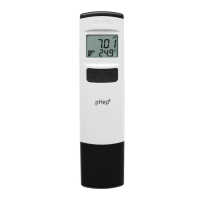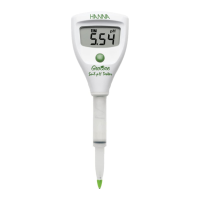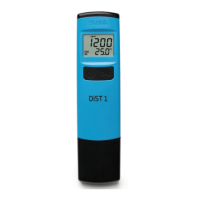Method ID: HI1012EN
Troubleshooting 2
Titrator Application Methods: General Methods - r. 2.3
Description:
A method for verifying the dosing accuracy of the
titrator. This method should be used troubleshoot a
titrator equipped with a 25-mL burette. The titrator
dispenses a 10.000-mL pre-titration volume, waits
10 seconds, and then dispenses an additional
0.500-mL dose 20 times, waiting 10 seconds
between each addition, bringing the total volume to
20.000 mL. This procedure can also be used to
check the stirrer functionality.
Reference:
ISO/TC 48/SC1N 380E to 383E: “Piston and/or
Plunger Operated Volumetric Apparatus”.
Accessories:
HI 762000C 0°C Temperature Key
HI 70436 Distilled Water (1 gal)
HI 7662-T Temperature Probe
Shorting cap
Analytical Balance with a minimum resolution of
0.0001 g is recommended
Narrow Neck Beaker
Small Dose Dispensing Procedure:
Connect the shorting cap to the BNC socket on
Analog Board 1.
Press “Select Method” from the main screen. Use
the arrow keys to highlight „HI1012EN
Troubleshooting 2‟ and press “Select”.
Install the 25-mL burette with HI 70436 room
temperature (25°C) distilled water on pump-one
and verify that no air bubbles are present in the
burette or tubing. If necessary prime until all air
has been removed completely.
Add a small amount of water to a narrow neck
beaker to have vapor-saturated air space just
above the liquid level and minimize evaporation.
Place the narrow neck beaker on an analytical
balance.
Zero the balance.
Place the dosing tip through the neck of the
beaker. Take care not to immerse it in the liquid
during dispensing and not to touch the beaker‟s
walls.
Press “Start” to start dosing.
Write down the mass read from the balance after
each dose.
The following information is needed to verify the
accuracy of the dosing system:
The temperature of the dispensed water
The atmospheric air pressure
The density of the weight used to calibrate the
balance
Note: This procedure can be repeated on pump 2
Method Parameters:
Name: Troubleshooting 2
Method Revision: 2.3
Titration Type: Standard Titration
Analog Board: Analog 1
Stirrer Configuration: Stirrer 1
Pump Configuration:
Titrant Pump: Pump 1
Dosing Type: Linear - 0.500 mL
End Point Mode: Fixed 10.0 mV
Pre-Titration Volume: 10.000 mL
Pre-Titration Stir Time: 0 sec
Measurement Mode: Timed Increment
t-incr. Wait: 10 sec
Electrode Type: Shorting Cap
Blank Option: No Blank
Calculations: No Formula (mL only)
Titrant Name: DI water
Maximum Titrant Volume: 20.000 mL
Stirring Speed: 0 rpm
Potential Range: -2000.0 to 2000.0 mV
Volume/Flow Rate: 25 mL/50 mL/min
Signal Averaging: 1 Reading
Significant Figures: XXXXX
Calculations:
The measured volume of the dispensed liquid is
calculated from the measured mass using the
following equation:
V Volume of measured mass of water [mL]
M
Measured mass of water [g]
L
Density of dispensed water [g/mL]
air
Density of ambient air [g/mL]
STD
Density of calibration standard weight [g/mL]
If the actual values of the above parameters are not
accessible the following equation can be used:
V Volume of measured mass of water [mL]
F Transformation factor
The transformation factor takes into account the air
buoyancy, the water density and their temperature
dependence. Standard values can be used to obtain
the transformation factor.
The values from the table below have been
calculated by correcting the air and water density
with temperature, assuming: dry air at 760 torr (dry
air at 760 torr and 20°C has a density
air
= 0.0012
g/mL) and density of calibration steel-standard
weights
STD
= 8 g/mL.
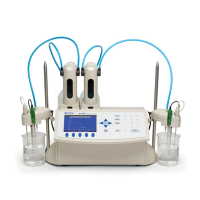
